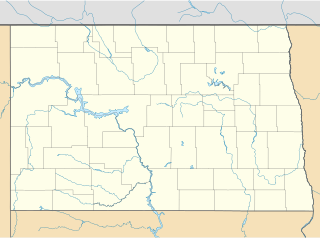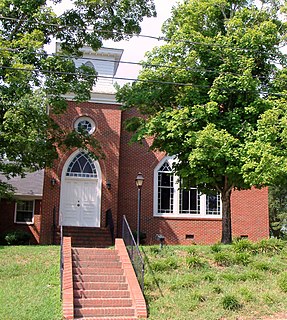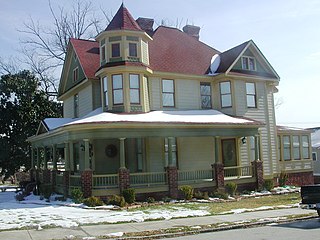
In the law regulating historic districts in the United States, a contributing property or contributing resource is any building, object, or structure which adds to the historical integrity or architectural qualities that make the historic district, listed locally or federally, significant. Government agencies, at the state, national, and local level in the United States, have differing definitions of what constitutes a contributing property but there are common characteristics. Local laws often regulate the changes that can be made to contributing structures within designated historic districts. The first local ordinances dealing with the alteration of buildings within historic districts was in Charleston, South Carolina in 1931.

Edenton Historic District is a national historic district located at Edenton, Chowan County, North Carolina. The district encompasses 342 contributing buildings, 4 contributing sites, and 3 contributing structures. It includes several buildings that are individually listed on the National Register. The Lane House, possibly the oldest surviving house in North Carolina, is owned by Steve and Linda Lane and is located within the district. Also located in the district are the Dixon-Powell House, William Leary House, and Louis Ziegler House designed by architect George Franklin Barber.

Southside Historic District is a national historic district located at Corning, Steuben County, New York. The district encompasses 624 contributing buildings, one contributing site and four contributing objects in a predominantly residential section of Corning. The district developed after 1835 and includes notable examples of Federal, Greek Revival, and Victorian architecture. Located in the district is the separately listed World War Memorial Library. Other notable buildings include the Steuben County Courthouse designed by J. Foster Warner, the "Voting Booth", Corning Free Academy (1922), the First United Methodist Church of Corning and Christ Episcopal Church.

There are 65 properties listed on the National Register of Historic Places in Albany, New York, United States. Six are additionally designated as National Historic Landmarks (NHLs), the most of any city in the state after New York City. Another 14 are historic districts, for which 20 of the listings are also contributing properties. Two properties, both buildings, that had been listed in the past but have since been demolished have been delisted; one building that is also no longer extant remains listed.

The Fairmount–Southside Historic District is a 340-acre (140 ha) historic district that has been listed on the National Register of Historic Places since 1990.

The Grand Forks Near Southside Historic District is a 182-acre (74 ha) historic district in Grand Forks, North Dakota that was listed on the National Register of Historic Places (NRHP) in 2004.

The Grand Forks Riverside Neighborhood Historic District is a 112-acre (45 ha) historic district in Grand Forks, North Dakota that was listed on the National Register of Historic Places in 2007.

"Elm Grove", also known as Long's Landing, is a historic home and national historic district located at Southside, Mason County, West Virginia. The district includes seven contributing buildings and one contributing structure. The manor house is a High Victorian Italianate-style brick farmhouse built in 1884. It features two round attic portholes and three porches. Also on the property is a two-story contributing log house built in 1803, 1920s bungalow, late 19th century barn, a large sandstone fireplace shaped kiln, three outbuildings, and the site of the first brick manor house built c. 1830.

The Arlington Forest Historic District is a national historic district located at Arlington County, Virginia. It contains 810 contributing buildings and 3 contributing sites in a subdivision in South Arlington and two sites in North Arlington. It was developed in four stages between 1939 and 1948, known as Southside, Northside, Greenbrier, and Broyhill's Addition. The district is characterized by orderly rows of detached two-story, single family dwellings with minimal Colonial Revival style decorative detailing. It is representative of a mid-20th century planned mixed use community in Arlington County.

The Boydton Historic District is a national historic district located at Boydton, Mecklenburg County, Virginia. It encompasses 199 contributing buildings, 6 contributing sites, 6 contributing structure, and 2 contributing objects in the central business district and surrounding residential areas of the town of Boydton. Notable buildings include the municipal building (1905), the old jail (1870), the Beales, Bedinger, and Gregory, Inc. car dealership building (1918), Washington Tavern, Williams and Goode Bank (1908), Boydton Department Store (1935), Mecklenburg County Building Department (1949), Southside Regional Library (1939), Presbyterian Meeting House (1819), Saint James Episcopal Church (1840-1841), Boydton Baptist Church, Trinity Episcopal Church (1890s), "Cedar Crest" (1825), and "On the Hill" (1920), which was separately listed in 2015. Also located in the district and separately listed are the Boyd's Tavern and Mecklenburg County Courthouse.

Miller–Southside Residential Historic District is a national historic district located at Blacksburg, Montgomery County, Virginia. The district encompasses 165 contributing buildings in a predominantly residential section of the town of Blacksburg. The residences date between 1909 and 1941, and are in a variety of popular architectural styles including American Foursquare, Bungalow, and Colonial Revival.

The Southside School, formerly known as Southside School Annex, at 190 E. Liberty in Reno, Nevada, was built in 1936 as an additional building to a 1903-built original building. Only the 1936 annex building survives. It was built with Works Progress Administration funding. It was listed on the National Register of Historic Places in 1993.

Washington Park Historic District, also known as the Southside Neighborhood, is a national historic district located at Winston-Salem, Forsyth County, North Carolina. The district encompasses 348 contributing buildings, 1 contributing site, and 2 contributing structures, in a predominantly residential section of Winston-Salem. It was a planned speculative development centered on a streetcar line. The buildings date from about 1892 to 1940, and include notable examples of Colonial Revival, Queen Anne, and Bungalow / American Craftsman style architecture. Notable buildings include the Schlatter Memorial Reformed Church (1916).

Waughtown–Belview Historic District is a national historic district located at Winston-Salem, Forsyth County, North Carolina. The district encompasses 1,137 contributing buildings, 1 contributing site, and 1 contributing object in a largely residential section of Winston-Salem. The buildings date from about 1834 to 1955, and include notable examples of Greek Revival, Colonial Revival, Queen Anne, and Bungalow / American Craftsman style architecture. Located in the district is the separately listed Shell Service Station. Other notable resources include the Clodfelter House, Fiddler House, Nissen Wagon Works smokestack, Triangle Body Works, Waughtown Baptist Church (1919), Waughtown Presbyterian Church (1914), Southside Christian Church, and Waughtown Cemetery.

South Greensboro Historic District, also known as the Asheboro Street Historic District, is a national historic district located in the Southside neighborhood, Greensboro, Guilford County, North Carolina. The district encompasses 327 contributing buildings, 1 contributing site, 10 contributing structures, and 1 contributing object in a predominantly residential section of Greensboro. The houses were largely built between the 1870s and the 1930s and include notable examples of Queen Anne, Italianate, American Foursquare, and Bungalow / American Craftsman-style architecture. Notable buildings include the Atkinson House, Hanner House, B.E. Jones House, T. Bernard House, C.O. Younts House, W.S. Witherspoon House, and R. N. Watson House, former Asheboro Street Church, and Nettie Mae Coad Apartments.

Plymouth Southside Historic District is a national historic district located at Plymouth, Marshall County, Indiana. The district encompasses 91 contributing buildings, 2 contributing structures, and 1 contributing object in a predominantly residential section of Plymouth. It developed between about 1853 and 1953, and includes examples of Italianate, Greek Revival, Queen Anne, Colonial Revival, and Tudor Revival style architecture. Notable contributing resources include the John McFarlin, Jr., House, Trinity United Methodist Church (1926), Bible Baptist Church (1894), Felke Florist and Greenhouse (1922), John Soice Residence, Westervelt-Marble Residence, and Edwards-Gambel Residence (1856).

Virginia Avenue District is a national historic district located at Indianapolis, Indiana. The district encompasses 43 contributing buildings and 1 contributing structure in the Fountain Square Commercial Areas of Indianapolis. It developed between about 1871 and 1932, and notable buildings include the Sanders (Apex) Theater (1913), Southside Wagon and Carriage Works / Saffel Chair Company, Fountain Square Theater (1928), Woessner Building, Granada Theater (1928), Southside Theater (1911), Schreiber Block (1895), Fountain Square State Bank (1922), and Fountain Bank (1902).

Munichburg Commercial Historic District is a national historic district located at Jefferson City, Cole County, Missouri. It encompasses nine contributing buildings in Jefferson City. The district developed between about 1892 and 1951, and includes representative examples of Early Commercial and One and Two Part Commercial architecture. Notable buildings include the Nieghorn House Hotel (1892), Southside Barber Shop, Schmidt Shoe Store (1908), Southside Dry Goods, Milo H. Walz Hardware Store, Milo H. Walz Furniture Store (1936), Henry Schmidt Grocery Store, Central Dairy, and Busch's Florist.

The Acworth Downtown Historic District, in Acworth, Georgia, is a historic district roughly bounded by Southside Dr., Federal and Lemon Sts, and Senator Richard B. Russell Ave. It is 14 acres (5.7 ha) in area and includes 32 contributing buildings and a contributing structure.




















